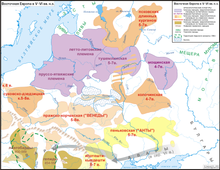Kriwitschen
The Kriwitschen (Russian Кривичи , wiss. Transl .: kriviči ) were an East Slavic tribe who settled on the upper Daugava around Polazk in today's Belarus and on the upper Dnepr around Smolensk in today's western Russia .
Distribution area
Kriwitschen settled in different areas according to the Nestor Chronicle
Archaeological research suggests Kriwitschen, too, based on characteristic Lang- Kurgane (barrows with elongated shape, 50 m × 7 m × 1 m)
- in the Pskov area along the Velikaya
origin
- The name is possibly derived from the Baltic.
- The entire area along the Daugava was a Baltic settlement area.
- Archaeological finds also revealed Baltic elements in the material culture
From all of this there is the possibility of an originally Baltic origin of part of the Kriwitschen.
history
According to the Nestor Chronicle , in 862 the Kriwitschen together with their neighbors, the Baltic Finnish Tschuden and Wes , as well as the Ilmenslawen called on the Scandinavian Varangians to rule over them.
Others
Probably after the Kriviches, Russia is called Krievija in the Latvian language .
literature
- Sedov, VV: Krivitschi , in: Sovjetskaja archeologija, Vol. 1, 1960
- Schich, MM: K voprosu ob etnitscheskoj prinadleshnosti krivitschej ( On the question of the ethnic origin of the Kriviches), Vestnik Lipezkovo gosudarstvennovo pedagogitscheskovo universiteta.Serija gumanitarnye nauki., Vol. 1 (8), 2013, pp. 8-17 online
- Schmidt, EA: Krivitschi Smolenskogo Podneprov'ja i Podvin'ja v svete archeologitscheskich dannych ( The Kriviches in the Smolensk Dnieper region and in the Dune region in the light of archaeological findings ), Smolensk 2012 online
Remarks
- ↑ Of these also the Kriviches, these settled on the upper Volga, and on the upper Daugava and the upper Dnieper, their city is Smolensk, that is where the Kriviches have settled
- ↑ The Estonian archaeologist M. Aun suspects the origin of the Lang Kurgane in the area of eastern Estonia east of Lake Peipus , see M. Aun: Kurgannye mogilniki Vostotschnoj Estonii wo wtoroj polowine 1 tysjatscheletija naschej ery ( Kurgane of eastern Estonia in the second half of the 1st half of Eastern Estonia Millennium of our era ), Tallinn 1980, the Russian archaeologist WW Sedow differentiates between two groups: one on Lake Peipus around Pskow (6th / 7th century) (settlement area of the Chuden ), a later one on the upper Dvina and Dnieper (8th / 9th centuries) . Jhd.) (Settlement area of the Kriwitschen), see WW Sedoow: Kultura pskowskich dlinnych kurganow ( culture of the long Kurgane near Pskow ) in: Slawjane w rannem srednewekowe , Moscow 1995, pp. 211-217, 416, online (Russian) ( Memento of the original dated June 11, 2003 in the Internet Archive ) Info: The archive link was inserted automatically and has not yet been checked. Please check the original and archive link according to the instructions and then remove this notice.
